Abstract
Single nerve cells can use more than one substance as extracellular chemical messengers. Classical transmitters have been shown to coexist in the same neuron and possibly even in the same vesicle as neuroactive peptides. Furthermore, multiple neuroactive peptides, which are thought to be coreleased, are often encoded in the same precursor assuring stoichiometric synthesis. The precise organization of multiple message systems and the physiological significance of the coexistence is poorly understood. The abdominal ganglion of the gastropod mollusc Aplysia contains a number of identified neurons that are cotransmitter candidates. One such cell, L11, is cholinergic and probably also uses biologically active peptides. Differential screening with labeled cDNA was used to isolate cDNA clones expressed specifically in the bag cells and abdominal ganglion neurons L11 or R15. Analysis of an L11-specific clone suggests that it encodes a 14.7-kDa protein that is the precursor for the secreted peptides. The poly(A)+ RNA transcript is approximately equal to 1.2 kilobases and there are 1-3 copies of this gene in the Aplysia haploid genome.
Full text
PDF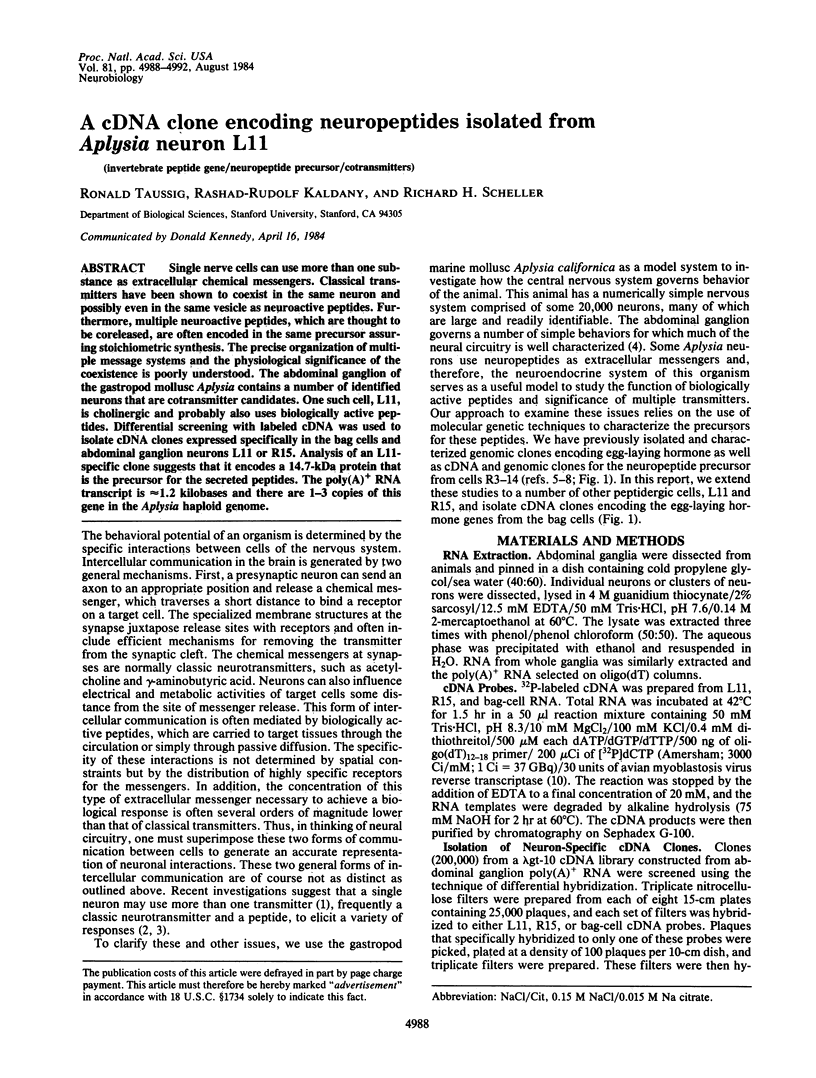
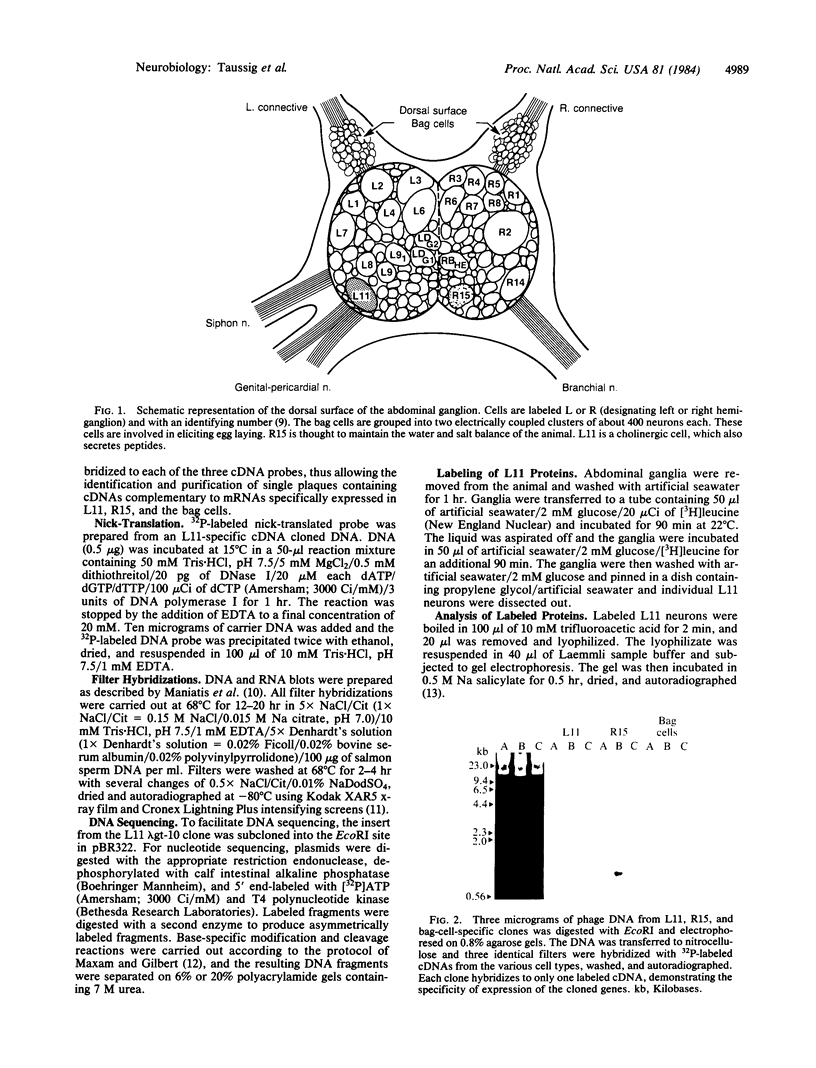
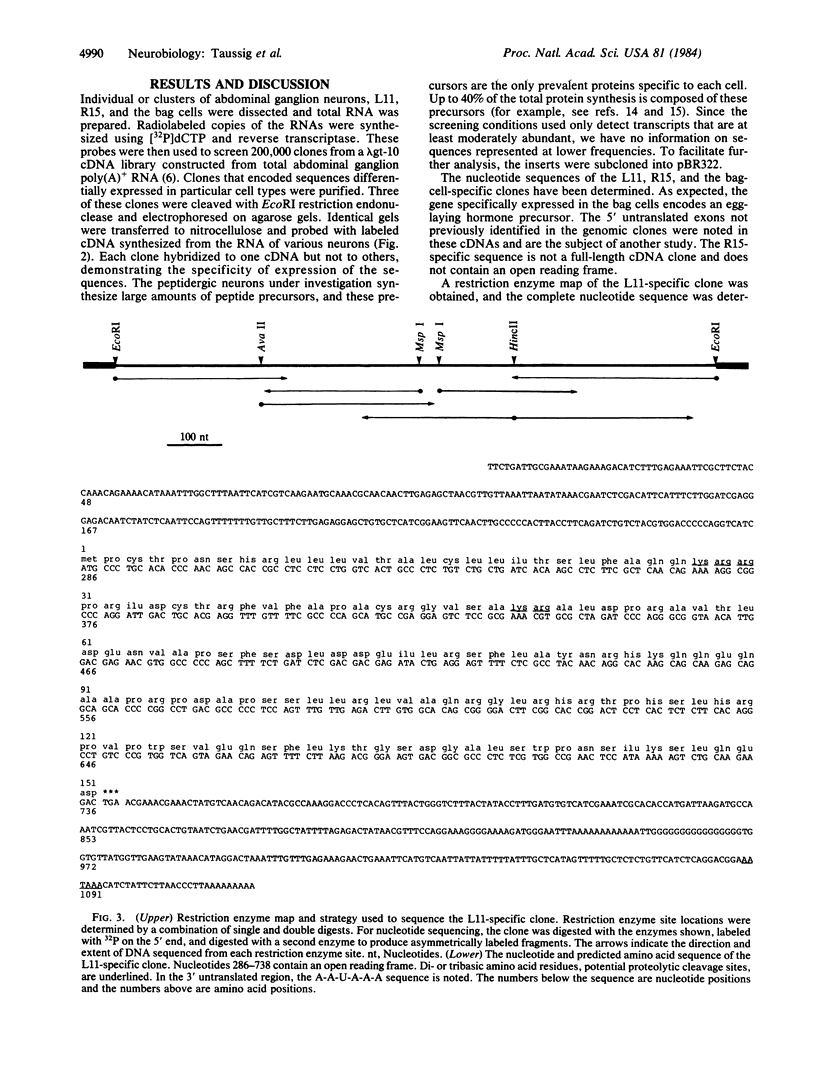
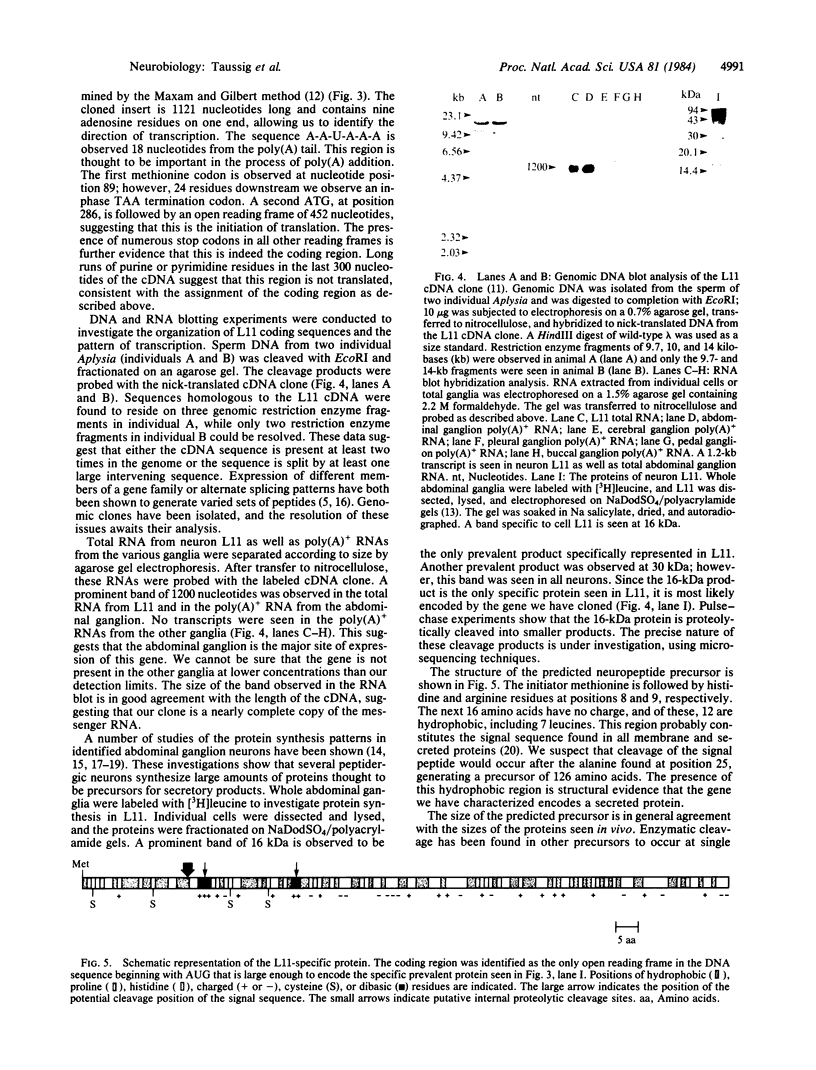
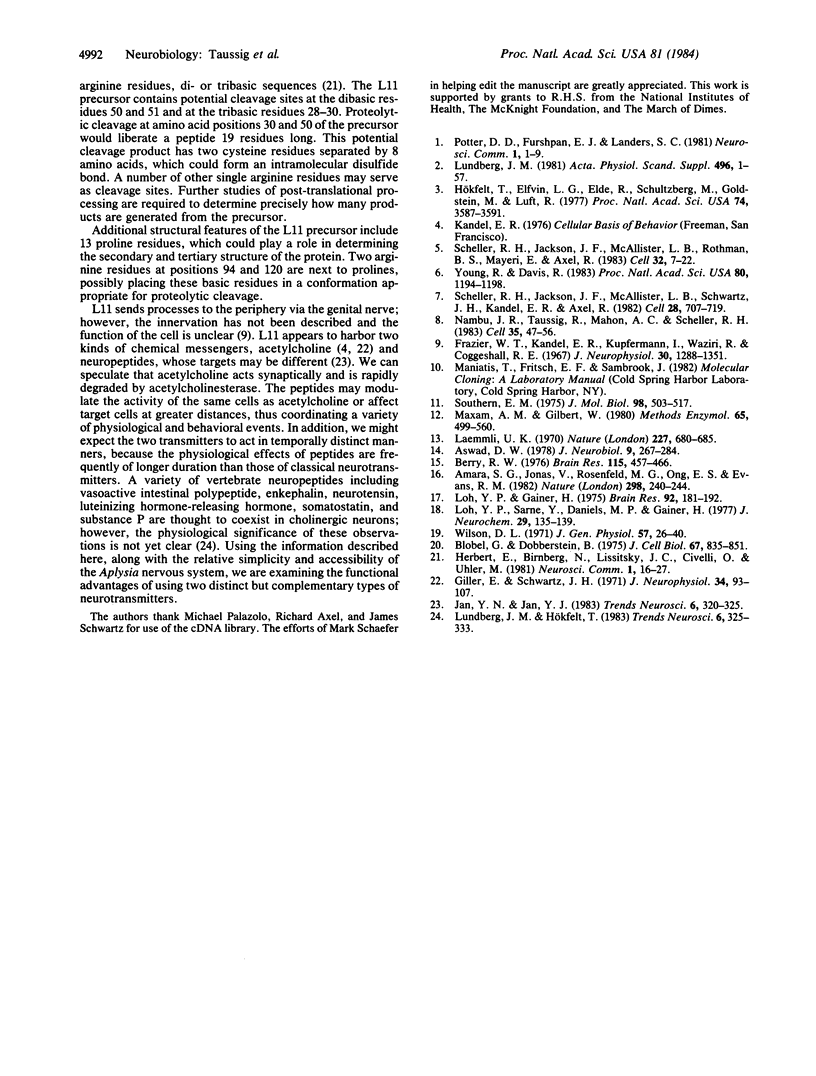
Images in this article
Selected References
These references are in PubMed. This may not be the complete list of references from this article.
- Amara S. G., Jonas V., Rosenfeld M. G., Ong E. S., Evans R. M. Alternative RNA processing in calcitonin gene expression generates mRNAs encoding different polypeptide products. Nature. 1982 Jul 15;298(5871):240–244. doi: 10.1038/298240a0. [DOI] [PubMed] [Google Scholar]
- Aswad D. W. Biosynthesis and processing of presumed neurosecretory proteins in single identified neurons of Aplysia californica. J Neurobiol. 1978 Jul;9(4):267–284. doi: 10.1002/neu.480090404. [DOI] [PubMed] [Google Scholar]
- Berry R. W. A comparison of the 12,000 dalton proteins synthesized by Aplysia neurons L11 and R15. Brain Res. 1976 Oct 22;115(3):457–466. doi: 10.1016/0006-8993(76)90361-9. [DOI] [PubMed] [Google Scholar]
- Blobel G., Dobberstein B. Transfer of proteins across membranes. I. Presence of proteolytically processed and unprocessed nascent immunoglobulin light chains on membrane-bound ribosomes of murine myeloma. J Cell Biol. 1975 Dec;67(3):835–851. doi: 10.1083/jcb.67.3.835. [DOI] [PMC free article] [PubMed] [Google Scholar]
- Giller E., Jr, Schwartz J. H. Choline acetyltransferase in identified neurons of abdominal ganglion of Aplysia californica. J Neurophysiol. 1971 Jan;34(1):93–107. doi: 10.1152/jn.1971.34.1.93. [DOI] [PubMed] [Google Scholar]
- Hökfelt T., Elfvin L. G., Elde R., Schultzberg M., Goldstein M., Luft R. Occurrence of somatostatin-like immunoreactivity in some peripheral sympathetic noradrenergic neurons. Proc Natl Acad Sci U S A. 1977 Aug;74(8):3587–3591. doi: 10.1073/pnas.74.8.3587. [DOI] [PMC free article] [PubMed] [Google Scholar]
- Laemmli U. K. Cleavage of structural proteins during the assembly of the head of bacteriophage T4. Nature. 1970 Aug 15;227(5259):680–685. doi: 10.1038/227680a0. [DOI] [PubMed] [Google Scholar]
- Loh Y. P., Gainer H. Low molecular weight specific proteins in identified molluscan neurons. I. Synthesis and storage. Brain Res. 1975 Jul 11;92(2):181–192. doi: 10.1016/0006-8993(75)90268-1. [DOI] [PubMed] [Google Scholar]
- Lundberg J. M. Evidence for coexistence of vasoactive intestinal polypeptide (VIP) and acetylcholine in neurons of cat exocrine glands. Morphological, biochemical and functional studies. Acta Physiol Scand Suppl. 1981;496:1–57. [PubMed] [Google Scholar]
- Maxam A. M., Gilbert W. Sequencing end-labeled DNA with base-specific chemical cleavages. Methods Enzymol. 1980;65(1):499–560. doi: 10.1016/s0076-6879(80)65059-9. [DOI] [PubMed] [Google Scholar]
- Nambu J. R., Taussig R., Mahon A. C., Scheller R. H. Gene isolation with cDNA probes from identified Aplysia neurons: neuropeptide modulators of cardiovascular physiology. Cell. 1983 Nov;35(1):47–56. doi: 10.1016/0092-8674(83)90206-4. [DOI] [PubMed] [Google Scholar]
- Peng Loh Y., Sarne Y., Daniels M. P., Gainer H. Subcellular fractionation studies related to the processing of neurosecretory proteins in Aplysia neurons. J Neurochem. 1977 Jul;29(1):135–139. doi: 10.1111/j.1471-4159.1977.tb03935.x. [DOI] [PubMed] [Google Scholar]
- Scheller R. H., Jackson J. F., McAllister L. B., Rothman B. S., Mayeri E., Axel R. A single gene encodes multiple neuropeptides mediating a stereotyped behavior. Cell. 1983 Jan;32(1):7–22. doi: 10.1016/0092-8674(83)90492-0. [DOI] [PubMed] [Google Scholar]
- Scheller R. H., Jackson J. F., McAllister L. B., Schwartz J. H., Kandel E. R., Axel R. A family of genes that codes for ELH, a neuropeptide eliciting a stereotyped pattern of behavior in Aplysia. Cell. 1982 Apr;28(4):707–719. doi: 10.1016/0092-8674(82)90050-2. [DOI] [PubMed] [Google Scholar]
- Southern E. M. Detection of specific sequences among DNA fragments separated by gel electrophoresis. J Mol Biol. 1975 Nov 5;98(3):503–517. doi: 10.1016/s0022-2836(75)80083-0. [DOI] [PubMed] [Google Scholar]
- Wilson D. L. Molecular weight distribution of proteins synthesized in single, identified neurons of Aplysia. J Gen Physiol. 1971 Jan;57(1):26–40. doi: 10.1085/jgp.57.1.26. [DOI] [PMC free article] [PubMed] [Google Scholar]
- Young R. A., Davis R. W. Efficient isolation of genes by using antibody probes. Proc Natl Acad Sci U S A. 1983 Mar;80(5):1194–1198. doi: 10.1073/pnas.80.5.1194. [DOI] [PMC free article] [PubMed] [Google Scholar]





